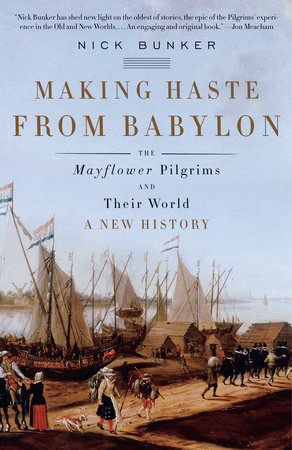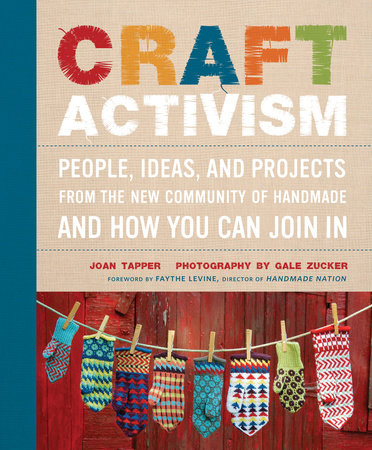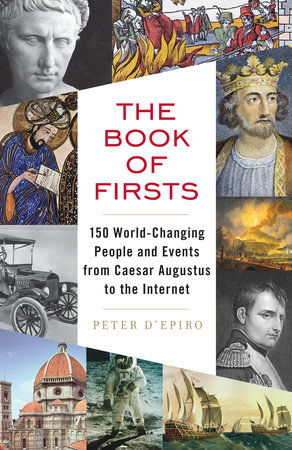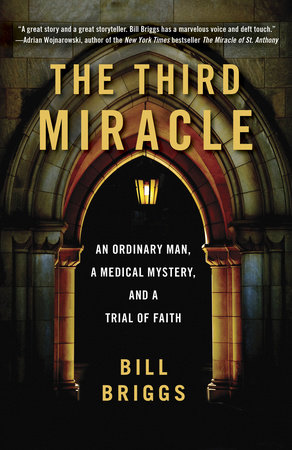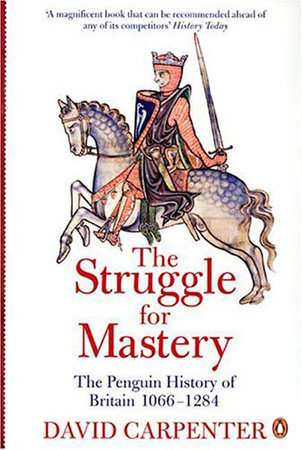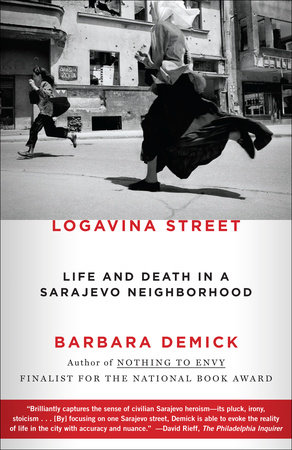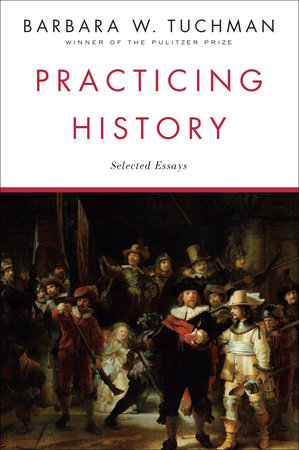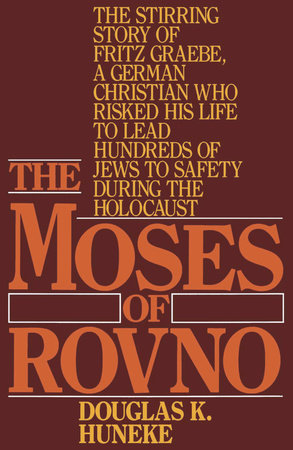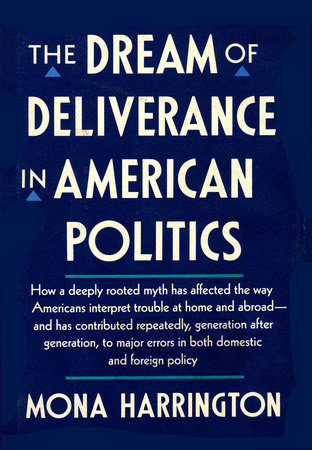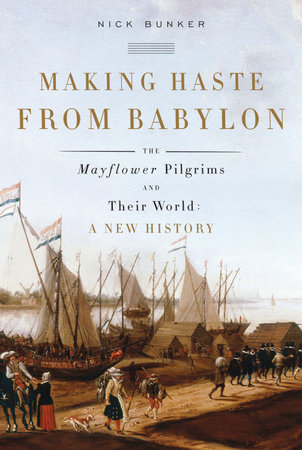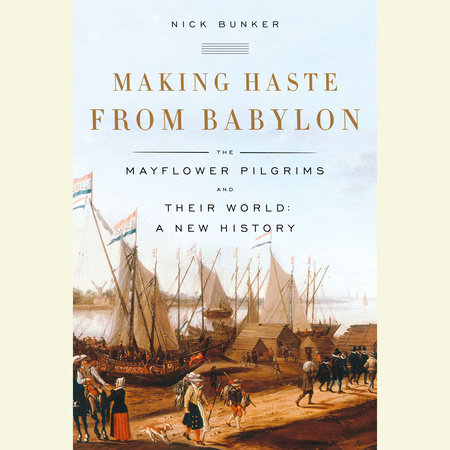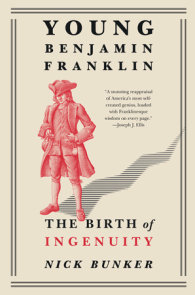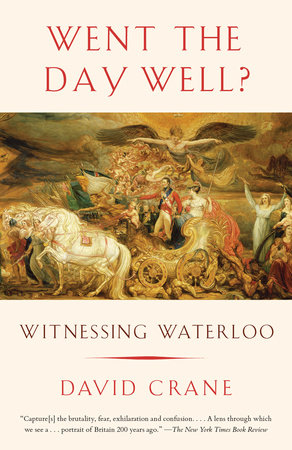Author Q&A
Q: What made you, as an Englishman, want to tell the story of the Mayflower Pilgrims?
A: Before they were American, they were English, and a revolutionary war had to be fought before the two nations separated for good. Long after the Mayflower, the history of England and America remained deeply intertwined. You can’t understand one without delving into the other as well.
In my case there’s also a family reason for my fascination with the American past. I’m called Bunker. In England we’re very few and far between. For centuries the Bunkers lived lives of total obscurity, as farmhands and farriers and the like in the countryside northwest of London. Except for one Bunker, a yeoman farmer called George, born in about 1600 in a village in deepest Bedfordshire.
His local parish clergyman made a name for himself as an outspoken Puritan. It seems that George Bunker listened to his sermons and became a Puritan himself. In 1632, he sailed to Massachusetts, most likely on the Lyon, a ship which also supplied the Plymouth Colony. He settled at Charlestown, where he gave his name to Bunker Hill, but George was a free-thinking man who upset the authorities by supporting the religious radical Anne Hutchinson. So they took away his gun, and banned him from holding public office. Even so, he did well. George Bunker became one of the earliest benefactors of Harvard College. His descendants were still living at Charlestown in 1775, when Bunker Hill became a battlefield, while their cousins, another lot of Bunkers, were whaling captains on Nantucket.
You won’t find George Bunker in Making Haste from Babylon, but his story wasn’t so very different from those of the Pilgrims on the Mayflower. It raises the same kind of questions. Exactly why did they embark on this bold, hazardous project called New England? What did they find when they arrived? How and why did they succeed, so that families like the Bunkers, who’d been unknowns in England, came to be entrepreneurs in America, the kind of people you read about in Moby Dick?
I find these questions fascinating, but very few Britons have shown any interest in answering them. That’s why I decided to write the book. I felt that it was time the story was told from an English perspective, and I guessed that historians had overlooked a mass of relevant material here in the United Kingdom.
Q: You have an unusual background. You’re not an academic specialist in early colonial history. You were a newspaper reporter, and then an investment banker before you turned to writing history. Have your past careers given you a unique perspective on the Pilgrims?
A: Not unique, but certainly wide-angled, which is valuable in itself. If we’re trying to understand the foundation of New England, we have to break down the barriers which universities create, boundaries been the history of economics, religion, politics, and the natural world. We need to recognise that a marine biologist or a farmer in rural Maine can have as much to offer by way of insight as a specialist in Puritan theology. We also have to be scrupulous about accuracy. Most of my career as a journalist was spent at the Financial Times, where accuracy always came first.
Q: You unearthed an extraordinary number of documents relating to the Pilgrims and the early settlement of New England, most of them virtually untouched. How did you find these records? And what do they reveal?
A: It’s a matter of timing. In the nineteenth century, when people started to look to the Pilgrim Fathers and the Mayflower as the inventors of America, scholars from New England began to make visits to London in search of archive material that might shed more light upon them. By the time of the tercentenary in 1920, it looked as though every relevant document had been discovered. Since then, many books have appeared about the Plymouth Colony, both academic and popular. But with only one or two exceptions the authors have relied entirely upon sources which were already in print a century ago.
Since 1945, record offices in England have made available huge quantities of new material from the Tudor and Stuart period, documents which were previously either hidden away in private hands, unlisted, or too badly damaged for use by scholars. Archivists have sorted out and numbered thousands of loose papers, created new catalogues, undertaken conservation projects, and become far more open and accessible. Of course, only a tiny fraction of their holdings relate to people involved in the settlement of New England. Even so they contain a wealth of relevant detail which simply wasn’t available to researchers until quite recently.
I tried to be methodical. I made lists of the names of people referred to in previous histories of the early colonists, and the locations from which they came. Then I travelled the length and breadth of England, visiting record offices, searching for manuscript material relating to them. That alone took me about eighteen months, with more time later devoted to visiting Northern Ireland, France and the Netherlands.
Let’s be clear: by itself, no single document will change our view of the Mayflower or New England. What I’ve done is to assemble a mosaic of fragments, as carefully as I can, to form a new picture of what happened. I hope it’s much clearer than anything exhibited before. I wanted to show exactly how things were: how faith, politics, business and the necessities of physical survival interacted with each other, to produce what we now call Puritan America.
Q: What is the single most important new source you discovered?
A: It’s always been thought that only one account survived of the flight of the Pilgrims from England across the North Sea to Holland in 1608, an account written by the Mayflower passenger William Bradford. I found it odd that such a dramatic event—nearly a hundred men, women and children, gathered on a beach to wait for a Dutch ship—should have left no trace in the State Papers.
So instead of using the catalogue, known as the Calendar of State Papers, I began to scroll through the entire microfilm of the original material from the year in question. It took half a day. Then suddenly I saw the names “Elvish” and “Stallingborough”. I recognized Elvish as an alternative spelling of the name of Thomas Helwys, a leading religious nonconformist and a man regarded as a hero by many modern Baptists. Stallingborough I also knew, as the name of a creek on the Humber estuary, next to the modern oil tanker terminal at Immingham.
I nearly fell off my chair when I realized that I’d found a set of depositions, sworn statements taken by the local magistrates immediately after the event. They fully describe what happened, with names, dates and locations. Historians have overlooked these documents because, when the State Papers were catalogued in about 1856, the Victorian archivists failed to see their significance. I went back to check the Calendar, and I found that yes, the depositions were listed, but the entry was brief and cryptic. It gives no indication of the importance of what lies behind it.
Q: One of the key features of your book is that it places the Mayflower in a new global context, connecting the Pilgrims not only to religion, but to political and economic forces as well. How does this change our understanding of the settlement of North America?
A: It makes the story richer and deeper, more adult and more inclusive, and it removes the myths and clichés.
The year 1620 was the equivalent, in the seventeenth century, of 1931 in the twentieth. Western Europe was sliding into an economic depression, and the continent was already at war: a war that would last for thirty years and leave millions dead. It was the conflict described by Brecht in his play Mother Courage, set in this same period, when New England was being created. Meryl Streep played the title role in Central Park a few years ago, as the woman who drags her cart from one grim German battlefield to another, while civilization collapses. Her performance was very accurate. In the early seventeenth century, life was very, very hard and getting harder. From the Baltic to the Mediterranean, millions of people were forced to go on the road, moving back and forth in search of something better: not just Puritans but also gypsies, Jews and Irish exiles, and a vast multitude of anonymous peasants, driven off their soil by war, taxes, and bankruptcy.
So the voyage of the Mayflower was simply the most famous of many migrations, in a world of trauma. If we see it like that, suddenly it ceases to be a quaint children’s tale. Instead, the Mayflower becomes a symbol of the experience of migrants of all kinds. Because we can find out much more about the Pilgrims than we can about most of the other exiles and refugees whom I mentioned, their story can be told with rare fidelity and accuracy. But I hope that many other kinds of people can see it as something relevant to their own lineage, even if they’re not white Anglo-Saxon Protestants like me and like Bradford.
Q: You also give us the story of the men in London who saw the Mayflower as a way to make money. What sort of men were they, and why did they get involved?
A: I began with the list of shareholders in the Virginia Company, which financed the settlement at Jamestown, and I compared it with the only available list of investors in the Plymouth Colony. There’s no overlap. That’s a very important finding in itself. It tells you that the merchants in London who backed the Pilgrims were new, untried men, young and with little capital, who were trying to make a risky fortune by opening up a new source of supply of beaver skins, a long way from Chesapeake Bay.
But, as you’d expect with any enterprise, the bulk of the money seems to have come from a core group who were far more highly motivated than the rest. They included John Pocock, a London merchant whose career I’ve tried to reconstruct. He was an unsung pioneer of American business. He put up cash to finance the first ironworks in North America, on the Saugus River next to Lynn, Massachusetts, where today a General Electric plant makes jet engines for airliners. But Pocock was also an evangelical Puritan, and that was essential too. Whether we agree with him or not, that was what made him persevere with New England, when others didn’t.
Q: The New World itself, along with many of its creatures, is just as prominent a character in your book as the Pilgrims. How did you learn so much about the land from the Kennebec Valley in Maine down to Cape Cod?
A: Nothing on earth exceeds the beauty of the American landscape, in grandeur, sublimity and scientific fascination. What’s more, the engagement with terrain and with nature has defined much of American history. So no writer should even begin to approach the origins of colonial New England without due preparation.
Much of my early work was done at the British Library in London, which has superb collections of scientific journals from America. I’ve also built up my own collection of topographical maps from the US Geological Survey, which I have shipped over from a store in Boulder, Colorado, and soil, crop and wildlife reports from the US Department of Agriculture and from state governments. In Boston, I did research in the magnificent public library in Copley Square, the Massachusetts Historical Society, and the state archives. Up in Maine I used the library at the historical society in Portland, and the excellent collections at the state library and museum in Augusta.
Then I rented a car, and headed for the hills with a pair of stout boots, warm clothing from L.L. Bean, and a clutch of reservations in the cheapest motels I could find. A year later I did it all again, in case I’d missed anything. I waded up and down the beaches and in and out of the salt marshes of Cape Cod, and I explored most of Plymouth County on a bicycle. I did much the same in England, by the way. It was great fun, and very healthy.
I wrote the final chapter of the book—The Last Shaman—over three days in a motel room in Bingham, Maine, a long way up the Kennebec River, just as the first winter snows were falling and the deer hunting season was beginning. Then I drove down to Skowhegan, and celebrated with steak and eggs for breakfast.
Q: One of these creatures, the beaver, plays a particularly vital role in the story. What was so important about beavers? What did they allow the Pilgrims to accomplish that previous settlements had not achieved?
A: Colonies in North America could not succeed without a rare, valuable commodity that they could package up and send back to London. Otherwise, they couldn’t pay down the debts they owed in the old country, debts they’d run up when they bought supplies to bring to Massachusetts or Virginia.
What did New England have to offer? Nothing better than beaver skins. They fetched a high price in London and Paris as raw material for producing felt, used to make sleek and fashionable beaver hats. The beaver hat was the Rolex watch, the Hermès scarf or the Prada handbag of its day, something every aspiring member of the English gentry wished to own. It’s ironic, since we think of the Pilgrims as austere, frugal people—which they were—but they built New England on the back of luxury goods. The critical breakthrough came in 1628, when the price of beaver pelts soared because of a sea war between England and France.
Q: You say that Thanksgiving was actually based in part on Jewish traditions. Can you explain the Jewish roots of Thanksgiving and how the Pilgrims came to study Judaism?
A: I think you have to look at the origins of Thanksgiving in two ways. The festive, turkey-eating side of Thanksgiving has its roots in an event in the fall of 1621, when the Pilgrims and the Wampanoag people who surrounded them held a kind of harvest festival. They ate venison and wildfowl, and exchanged presents.
However, Thanksgiving has another dimension, which is religious. It’s about giving thanks. And if you study William Bradford’s narrative carefully, you will see that there was an earlier Thanksgiving, at the very moment when the Mayflower first dropped anchor in American waters, at Provincetown in November 1620. Bradford says that they “fell upon their knees and blessed the God of Heaven, who brought them over the vast and furious ocean.”
Now, whenever you read William Bradford, you need to have a Bible close at hand and preferably also a concordance with a dictionary of biblical words and phrases. You will find that in describing their arrival on Cape Cod, he used language taken from Psalm 107. This is very significant, because that psalm was the source of a Jewish thanksgiving prayer, called the birkat ha-gomel. Devout Jews are required to say the prayer when they reach the end of a journey safely. The Pilgrims copied the same ritual and performed it themselves.
We can be absolutely sure that Bradford knew that this way of giving thanks had Jewish origins. We know that he and his comrades greatly admired an English scholar called Henry Ainsworth, whose books traveled to America with them. Ainsworth belonged to a generation of English religious writers who, in the 1590s, became fascinated by Hebrew, Judaism, and by the commentaries on the Bible written by the rabbis of the Middle Ages. They believed that you had to study Hebrew if you wished to understand the Word of God and they treated the rabbis with great respect.
Ainsworth wrote his own commentary on Psalm 107, and he specifically refers to the birkat ha-gomel. He quotes from the great Jewish philosopher Maimonides, who traced the prayer back to its roots in this psalm. Later in life William Bradford began to learn Hebrew himself.
Q: One misconception that you try to correct in your book surrounds the lives the Pilgrims led in England. What was their experience really like?
A: They weren’t poor, but even so they endured an existence that we would find intolerable. It wasn’t a peaceful rural idyll. The best comparison I can give is with the plains of northern India today, along the valley of the Ganges in Bihar and Uttar Pradesh, where conditions in the early 21st century resemble those in Jacobean England.
In other words, the Pilgrims came from an environment where the earth produced a meagre crop. Incomes were mostly tiny. Society was divided into a hierarchy of caste and status, and the gap between rich and poor was becoming wider and wider. People felt very insecure because of the risk of slipping downwards into poverty, and so they quarrelled and squabbled with each other.
Like the people of modern India, the Pilgrims could vote in elections and debate politics, but just like modern Indians they took religion far more seriously than anything else. All too often it gave rise to sectarian conflict, of the kind you encounter in Asia in our time. And in the time of James I, you couldn’t trust your local government, because it was run by landowners with their own agenda: principally, looking after their own relatives and friends.
In fact, it was when I spent six weeks travelling up the Ganges, from Calcutta to the Himalayas, that I first began to think about this project. It happened very late one night in February 2004, as I was waiting for a train at Lucknow Junction. I saw a group of Hindu pilgrims returning from a shrine in the countryside. That planted the idea in my mind, though it was only in 2006 that I was able to start work.
Q: You write about the prominent role the press played in the success of the Pilgrims’ colony. How did the press operate in the 1620 and how did it help ensure their survival?
A: Newspapers were very, very new, but they already did what the modern press does: they told striking, unusual stories about war, crime, and kings and queens. Like so many other innovations, the newspaper began in the Dutch Republic, where the first examples appeared in 1618. It’s easy to see why. Not far away, the Thirty Years’ War was beginning to escalate. The Dutch wanted to know what their old enemies, the Spanish, were up to.
The idea soon caught on in London too. The first genuine British newspaper—a regular, weekly publication, sold for a few pence, and dealing with current affairs—appeared in the autumn of 1621. The timing couldn’t have been better. Newspapers created a taste for exciting, topical journalism, and that was what the Pilgrims could provide.
Before he sailed on the Mayflower, Edward Winslow had been apprenticed to a printer and publisher in London. His contacts included the men who were pioneering this new medium. So, when the Pilgrims wrote a narrative of their earliest adventures in New England, Mourt’s Relation, they easily found a publisher. It appeared in print in 1622. Then Winslow wrote a sequel, called Good News from New England, which came out two years later.
This sort of thing was extremely important. Think about Jamestown, Virginia, which received a terrible press in England because of disease, internal strife, and bloody conflict with the Native Americans. Colonies needed flows of new investment from home, to keep them going until they achieved critical mass. So you needed to market and promote yourselves. That was what Winslow did, with the help of this new invention called journalism. The Plymouth Colony soon had a much better reputation than Jamestown. That (plus the beaver trade) helped attract a much bigger second wave of migrants to Massachusetts in 1630.
